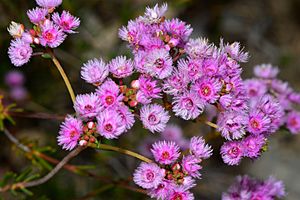Shy featherflower facts for kids
Quick facts for kids Shy featherflower |
|
|---|---|
 |
|
| Verticordia fimbrilepis subsp. fimbrilepis | |
| Scientific classification | |
| Genus: |
Verticordia
|
| Species: |
fimbrilepis
|
The Shy featherflower (scientific name: Verticordia fimbrilepis) is a beautiful flowering plant that belongs to the myrtle family, called Myrtaceae. This special plant only grows in the south-west part of Western Australia, meaning it's endemic there. It's a small, bushy plant with a main stem that branches out. It has tiny, pointed leaves and pretty pink flowers that grow in round clusters at the ends of its branches.
Contents
What Does the Shy Featherflower Look Like?
The Shy featherflower is a shrub that usually grows to be about 30 to 70 centimeters (about 1 to 2.3 feet) tall and wide. It has a main stem that branches out, giving it a bushy shape.
Leaves and Stems
The leaves lower down on the stems are thin and almost round. They are quite small, only about 2 to 5 millimeters (0.08 to 0.2 inches) long. Each leaf has a rounded end with a sharp tip. The leaves closer to the flowers are a bit different, shaped more like a narrow egg.
Flowers and Their Features
The flowers of the Shy featherflower grow in round groups on small stalks. These stalks are about 2 to 15 millimeters (0.08 to 0.6 inches) long and are found near the ends of the branches.
- Floral Cup: The base of the flower, called the floral cup, is shaped like a wide top. It's about 1.5 millimeters (0.06 inches) long and feels smooth but a little rough.
- Sepals: The sepals are usually pink, but sometimes they can be white. They are about 3 to 3.5 millimeters (0.12 to 0.14 inches) long and have 5 to 7 fuzzy, hair-like parts.
- Petals: The petals are also pink or white and are about 2.5 to 3.0 millimeters (0.10 to 0.12 inches) long. They are egg-shaped and covered with long, coarse hairs.
- Style: The style, which is part of the flower's reproductive system, is very short, only about 0.2 to 0.4 millimeters (0.008 to 0.016 inches) long. It's straight and smooth.
This plant usually blooms from November to December or even into January.
How Was the Shy Featherflower Named?
The Shy featherflower was first officially described in 1847 by a scientist named Nikolai Turczaninow. He published his description in a science journal called Bulletin de la Société Impériale des Naturalistes de Moscou. The plants he studied were collected by another botanist, James Drummond.
The scientific name fimbrilepis comes from two words:
- fimbria, which is Latin for "fringe"
- lepis, which is Greek for "a scale"
This name likely refers to the fringe-like parts of the flower.
Different Types of Shy Featherflower
In 1991, a scientist named Alex George identified two slightly different types, or subspecies, of the Shy featherflower. Both of these are recognized today:
- Verticordia fimbrilepis subsp. fimbrilepis has flower stalks that are shorter, about 2 to 4 millimeters (0.08 to 0.16 inches) long.
- Verticordia fimbrilepis subsp. australis has longer flower stalks, about 5 to 15 millimeters (0.2 to 0.6 inches) long.
Where Does the Shy Featherflower Grow?
This special plant grows in sandy areas that are low to the ground. You can find it in different types of plant communities, like heathlands (areas with small shrubs), shrublands, and wandoo woodlands. It's found in scattered spots near towns like Brookton and Narrogin in Western Australia.
Protecting the Shy Featherflower
Even though the Shy featherflower as a whole is currently classified as "not threatened," its two subspecies need special attention. Both subspecies are considered "Threatened" by the Western Australian Government Department of Parks and Wildlife. This means they are either rare or might become extinct if not protected.
- The subspecies fimbrilepis is listed as "Endangered" (EN) under the Australian Government's Environment Protection and Biodiversity Conservation Act 1999 (EPBC Act). This means it's at very high risk of disappearing in the wild. A plan is being put in place to help it recover.
- The subspecies australis is listed as "Vulnerable" under the same Act, meaning it's also at risk, but not as immediately as "Endangered."
Growing Shy Featherflowers
Both types of Shy featherflower are small, open shrubs with delicate pink flowers. However, it's been found that only the subspecies australis is easy to grow in gardens, and so far, mostly in Western Australia.
Images for kids


